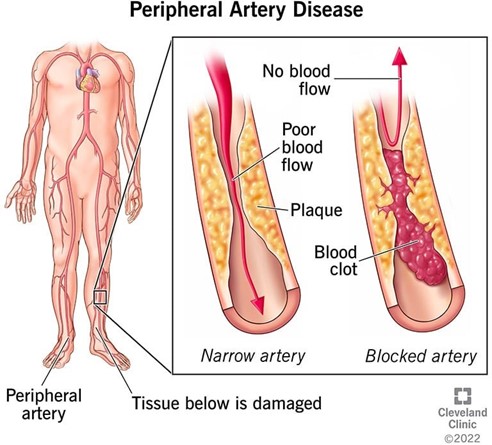While performing an admission assessment for a client, the nurse notes that the client has varicose veins with ulcerations and lower extremity edema with a report of a feeling of heaviness. Which of the following nursing diagnoses should the nurse identify as being the priority in the client's care?
Alteration in body image
Alteration in activity tolerance
Impaired tissue perfusion
Impaired skin integrity
The Correct Answer is C
Impaired tissue perfusion is a nursing diagnosis that indicates a decrease in oxygen and nutrient delivery to the tissues, resulting in cellular dysfunction and potential tissue damage or necrosis. It is the priority nursing diagnosis for a client who has varicose veins with ulcerations and lower extremity edema, as these are signs of chronic venous insufficiency, which is a condition in which the veins in the legs fail to return blood to the heart effectively, causing blood to pool and stagnate in the lower extremities. This leads to increased venous pressure, inflammation, and impaired wound healing, which can cause skin breakdown, infection, and tissue necrosis. The nurse should monitor the client's vital signs, peripheral pulses, capillary refill, skin color, temperature, and sensation, and implement interventions to improve venous return and prevent further complications, such as elevating the legs, applying compression stockings, encouraging ambulation, administering medications, and providing wound care.
Alteration in body image. This is a nursing diagnosis that indicates a negative perception or dissatisfaction with one's physical appearance or function. It may be applicable for a client who has varicose veins with ulcerations and lower extremity edema, as these may affect their self-esteem and social interactions. However, it is not the priority nursing diagnosis for this client, as it does not pose an immediate threat to their health or safety.
Alteration in activity tolerance. This is a nursing diagnosis that indicates a decrease in the ability to perform physical activities without experiencing fatigue, dyspnea, or other symptoms. It may be applicable for a client who has varicose veins with ulcerations and lower extremity edema, as these may limit their mobility and endurance. However, it is not the priority nursing diagnosis for this client, as it does not pose an immediate threat to their health or safety.
Impaired skin integrity. This is a nursing diagnosis that indicates a disruption or damage to the epidermis or dermis layers of the skin. It is applicable for a client who has varicose veins with ulcerations and lower extremity edema, as these can cause skin breakdown and infection. However, it is not the priority nursing diagnosis for this client, as it is a consequence of impaired tissue perfusion, which is the underlying problem that needs to be addressed first.
Nursing Test Bank
Naxlex Comprehensive Predictor Exams
Related Questions
Correct Answer is D
Explanation
The nurse should check the client's vital signs first because nausea and weakness are signs of digoxin toxicity, which can also cause bradycardia, hypotension, and arrhythmias. The nurse should also assess the client's serum digoxin level, potassium level, and electrocardiogram.
Request a dietitian consult is wrong because it is not the priority action and it does not address the possible cause of the client's symptoms. A dietitian consult may be helpful to provide nutritional education and guidance, but only after ruling out or treating digoxin toxicity.
Suggest that the client rests before eating the meal is wrong because it is not the priority action and it may delay the diagnosis and treatment of digoxin toxicity. The nurse should not assume that the client's symptoms are due to fatigue or lack of appetite, but rather investigate for any underlying problems.
Request an order for an antiemetic is wrong because it is not the priority action and it may mask the symptoms of digoxin toxicity. The nurse should not administer any medications that could interact with digoxin or worsen its effects, but rather notify the provider and follow the protocol for digoxin toxicity management.
Correct Answer is C
Explanation
feet or toes that occurs at night and is not relieved by rest.

Whether you are a student looking to ace your exams or a practicing nurse seeking to enhance your expertise , our nursing education contents will empower you with the confidence and competence to make a difference in the lives of patients and become a respected leader in the healthcare field.
Visit Naxlex, invest in your future and unlock endless possibilities with our unparalleled nursing education contents today
Report Wrong Answer on the Current Question
Do you disagree with the answer? If yes, what is your expected answer? Explain.
Kindly be descriptive with the issue you are facing.
